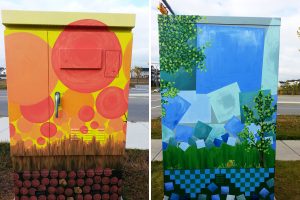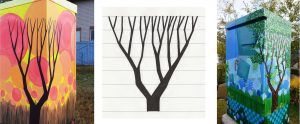I’m interested in public art because I think that art should be everywhere for us to look at, talk about and think about! Thanks for all the support as I’ve worked on the 2 utility boxes in Copperfield. Your comments as you have been passing by have meant a lot! I’d like to send a special thank you to Joylynn Matheson, your City of Calgary Neighbourhood Partnership Coordinator, the board of the community association and the staff at Copperfield and St. Isabella Schools (and Anna who brought me a hot coffee on a cold morning).
As I researched this community to develop my design, the idea of growth was prominent. This community has seen a 78% increase in population between 2009 and 2014 and this growth is still moving forward as housing in the area continues to be built. This community is made up of a higher than average number of young families with a lot of children aged nine and under (City of Calgary Community Profiles information.)
To visually represent the growth in the community I incorporated increasing (growing) patterns into the paintings on the utility boxes. You may have been following the clues to help you find these patterns!
The Riddle
Each utility box painting has three of these in it.
Each of these three things is the same.
Each of these three things is different.
What did I put in the paintings?
The Answer
Each utility box painting has three growing (increasing) patterns in it.
These patterns are the same in that they are all growing patterns.
These patterns are different in the increment by which they grow.
Growing Pattern 1: On the bottom of both boxes is a growing pattern that increases plus 2
![]()
![]()
Growing Pattern 2: The background circles and squares increase times 2 (if measuring diameter) or times 4 (if measuring area)

Growing Pattern 3: The tree branches on the large oak trees increase following a Fibonacci sequence (1, 2, 3, 5, 8, 13, 22 … add the two previous numbers together to get the next one ie. 1+2=3, 2+3=5, 3+5=8… there are lots of great images and videos on-line that demonstrate the Fibonacci pattern as it shows up in nature)

As a newer area, there are a lot of young plants and trees in resident’s yards and in the parks and common spaces. One of these trees is the Bur Oak which The City of Calgary recommends as one of the Top Tree Species for Calgary because it is
- a slow growing tree that is hardy to our climate,
- a tree that provides food and shelter for wildlife
- can be enjoyed by generations to come (Wikipedia says these trees can grow up to 400 years old!
I’ve incorporated oak(ish) trees (with a bit of artistic license taken) into my design. Planting these kinds of trees is a look ahead to the future. How do you imagine your community in 10, 25, 50 or 100 years?

Comments are closed, but trackbacks and pingbacks are open.